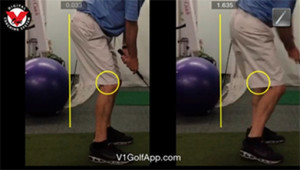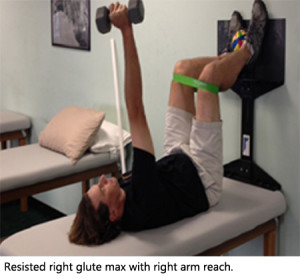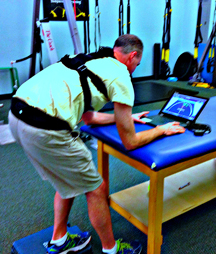by Chris Poulin
Why Golf is More Difficult for Right-handers
One of the most epidemic movement dysfunctions in golf is the inability of right-handed players to rotate around their lead hip. The lack of proper left hip position can lead to blocks, pulls, over the top, and a propensity of low back pain. With this in mind, what follows is some important context and practical solutions geared to the right-handed golfer—and unfortunately for left-handed players, addressing these issues is not as easy as simply reversing everything.
Over 92% of the world is right hand dominate, and an even greater number of left hand dominate players like Henrik Stenson are left-handed yet play golf right-handed. Throughout my years of studying the teachings of Ron Hruska of the Postural Restoration Institute (PRI), I have come to a realization regarding why most right-handed players find the game harder than their left-handed counterparts. Through my work with PRI I have a greater appreciation of how handedness, breathing, eye dominance, and malocclusions all affect how we swing a golf club.
The right-handed patterned golfers have a tendency to rely on their right side more than their left to do things such as lining up a drive, reading a putt, picking a ball out of the hole, teeing a ball up, and simply waiting for another player to hit or swing the club. This habit of using your right side while neglecting your left makes you asymmetrical. It’s that simple. Sprinkle on top of that the thousands of times right-handed golfers turn their shoulders to the right to make a backswing, and it becomes predictable that their bodies will take on a new form.
Assessments and Data Analysis
In the clinical setting right-handers will typically demonstrate that their pelvis is tipped forward on the left side, and this is the start of what is driving them to bear weight more on their right side (see Figure 1). They will have muscles in their abdomen and hips adapt to the new position, and then make adjustments in the thorax to compensate. When this happens the right shoulder will usually tip forward and they excessively side bend to the right, and stay side bent throughout their swing. As you can see in the young golfer in Figure 2, the spine becomes twisted and the right side of the neck has increased demands placed upon it.
When performing our assessment of golfers they will demonstrate more pelvis rotation in the backswing to the right and very little pelvic rotation to the left at impact. They will struggle balancing on their left leg compared to the right, and show a flat shoulder plane in the backswing because of the over-dominate right abdominals. We use K-VEST to capture this data to offer the objective numbers that help guide our corrective program. The K-VEST data that is typical of this program is seen below.

When assessing the video analysis, we use a down-the-line view that will show the pelvis has moved toward the golf ball at impact relative to where it was at address. This swing characteristic is called “early extension” and is often coupled with increased flexion of the lead knee as seen below.

Ideally, we would like to see the hips still on the line drawn behind the body and the left knee generally straight. The following exercises are designed to correct the physical limitations that are the possible cause for this swing fault. They represent some practical corrective steps you can take to reposition, restore, and, finally, retrain.
Exercise 1: Reposition
Golfers with a forward pelvis are more likely to injure their backs and lose distance. The following program will help most golfers who struggle with low back pain and are the short hitters in their group. It is not by any means a comprehensive program, and please perform these exercises only after obtaining permission from your physician.
Directions:
 and hips bent at a 90-degree angle. Place a 4-6 inch ball between your ankles and a band around your knees.
and hips bent at a 90-degree angle. Place a 4-6 inch ball between your ankles and a band around your knees.
Exercise 2: Restore
It is imperative to restore normal function of the left hip after repositioning it to its neutral position. Your body will likely find this extremely challenging. The purpose of this exercise is to train the inner thigh and outside hip to properly stabilize the pelvis as your hip rotates over a stable leg.
Directions:
Exercise 3: Retrain
Once your body is in the proper position and you’re aware of how to properly activate the muscles needed to incorporate an efficient golf swing, it is time to train. If you’re using a K-VEST to perform the exercise below, you want pelvis 5 degrees of anterior tilt (sagittal plane), 7 degrees of sidebend (frontal plane) and 20 degrees of rotation (transverse plane). [insert attached Poulin photo around here somewhere—I believe it should be associated only with this third exercise. -PG]
Directions:



Chris Poulin is a certified athletic trainer and strength and conditioning specialist with over 20 years experience. He maintains certifications with the NSCA, PRI, NATA, NASM and TPI; he is also a member of the first class of certified athletic trainers to be recognized by the Postural Restoration Institute and earning the PRT credential. A co-owner of Sandhills Sports Performance in Southern Pines North Carolina, he specializes in athletic development and reconditioning.
Link: www.sandhillssp.com
The MLB Winter Meetings brings together baseball executives, coaches, media, exhibitors and job seekers from around the world to network, fill job openings, attend educational workshops and discuss innovating trends in the industry. It’s one of the highlights of our…
Agreement to Accelerate Improvement Across All Levels of the Organization (SCOTTSDALE, Ariz.) K-MOTION – the leader in 3D evaluations and biofeedback training solutions for coaches and athletes – announces an agreement with the Baltimore Orioles to become the organization’s Player…
By Joe DiChiara and Jason Meisch You take a swing and don’t like where the golf ball goes. You want to know what happened, so you turn to your launch monitor. You look at the club face numbers. They tell…